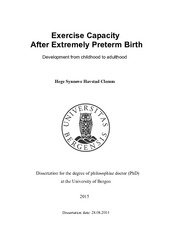Exercise Capacity after extremely preterm birth. Development from childhood to adulthood
Doctoral thesis
Permanent lenke
https://hdl.handle.net/1956/10705Utgivelsesdato
2015-08-28Metadata
Vis full innførselSamlinger
Sammendrag
Background: Extremely preterm (EP) birth is associated with a series of adverse health outcomes, some of which may be alleviated by improved physical fitness. Subjects born EP are reportedly less physically active than term-born peers, measures of exercise capacity are poorly described and longitudinal changes are unknown. Aims: To investigate associations between EP birth and exercise capacity in later life. Methods: Two area-based cohorts born at gestational age ≤ 28 weeks or with birth weight ≤ 1000 grams in 1991-1992 and in 1982–1985 were examined at 10 and 18 and at 18 and 25 years of age together with matched term-born controls using an identical maximal cardio-pulmonary treadmill exercise-test and validated questionnaires. The main outcome variables were maximal oxygen consumption and the distance completed at the exercise test. Main Results: Measures of exercise capacity was decreased by approximately 10% in EP-born compared to matched term-born control groups; however, with mean values within levels considered normal. Differences between EP-born and term-born controls were largely explained by differences between the males, but this apparent gender difference did not reach statistical significance when tested with interaction terms. Changes in exercise capacity from 10 to 18 and from 18 to 25 years of age did not differ from what was observed for term-born controls. A neonatal history of surgical closure of a patent ductus arteriosus was a risk factor for left-sided laryngeal paralysis with an associated increased risk of respiratory symptoms and airway obstruction, but exercise capacity was not reduced. A neonatal history of bronchopulmonary dysplasia was unrelated to current measures of exercise capacity, and we were unable to disentangle strong associations between neonatal factors and later exercise capacity. Current FEV1 was unrelated to measures of exercise capacity. At 10 years of age, no associations were observed between reported physical activity and peakV̇ O2, whereas at older ages these two variables were significantly and positively associated in both the EP-born and term-born groups in both participating birth-cohorts. Conclusion: Mean exercise capacity was approximately 10% poorer in EP-born than term-born participants; however, values were basically normal and unrelated to most neonatal factors and to current FEV1. Changes from mid childhood to adulthood were parallel in the EP-and term-born groups. A positive association between exercise capacity and self-reported physical activity developed through puberty in both the EP and term-born groups, suggesting similar trainability.
Består av
Paper 1: Aerobic capacity and exercise performance in young people born extremely preterm. Clemm H, Røksund O, Thorsen E, Markestad T, Halvorsen T. Pediatrics. 2012 Jan;129(1):e97-e105. Full text not available in BORA due to publisher restrictions. The published version is available at: http://dx.doi.org/10.1542/peds.2011-0326Paper 2: Exercise capacity after extremely preterm birth: development from adolescence to adulthood. Clemm HH, Vollsæter M, Røksund OD, Eide GE, Markestad T, Halvorsen T. Annals of the American Thoracic Society. 2014 May;11(4):537-45. Full text not available in BORA due to publisher restrictions. The published version is available at: http://dx.doi.org/10.1513/annalsats.201309-311oc
Paper 3: Exercise capacity after extremely preterm birth: Changes from childhood to adulthood. Clemm HH, Vollsæter M, Røksund OD, Markestad T, Halvorsen T. Published as: Adolescents who were born extremely preterm demonstrate modest decreases in exercise capacity. Acta Paediatrica. 2015 Nov;104(11):1174–1181. Full text not available in BORA due to publisher restrictions. The published version is available at: http://dx.doi.org/10.1111/apa.13080
Paper 4: Left vocal cord paralysis after extreme preterm birth, a new clinical scenario in adults. Røksund OD, Clemm H, Heimdal JH, Aukland SM, Sandvik L, Markestad T, Halvorsen T. Pediatrics. 2010 Dec;126(6):e1569-77. Full text not available in BORA due to publisher restrictions. The published version is available at: http://dx.doi.org/10.1542/peds.2010-1129
